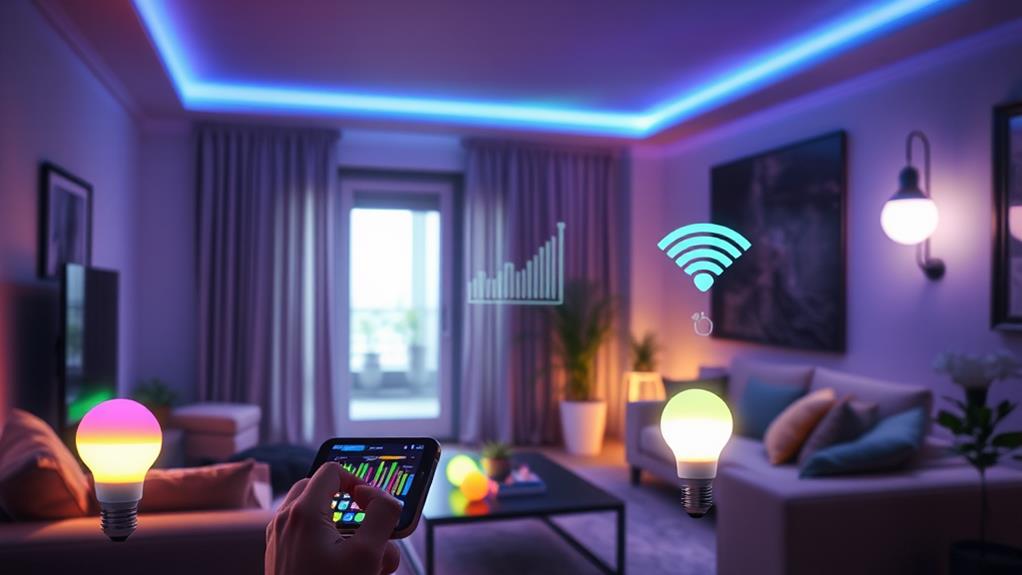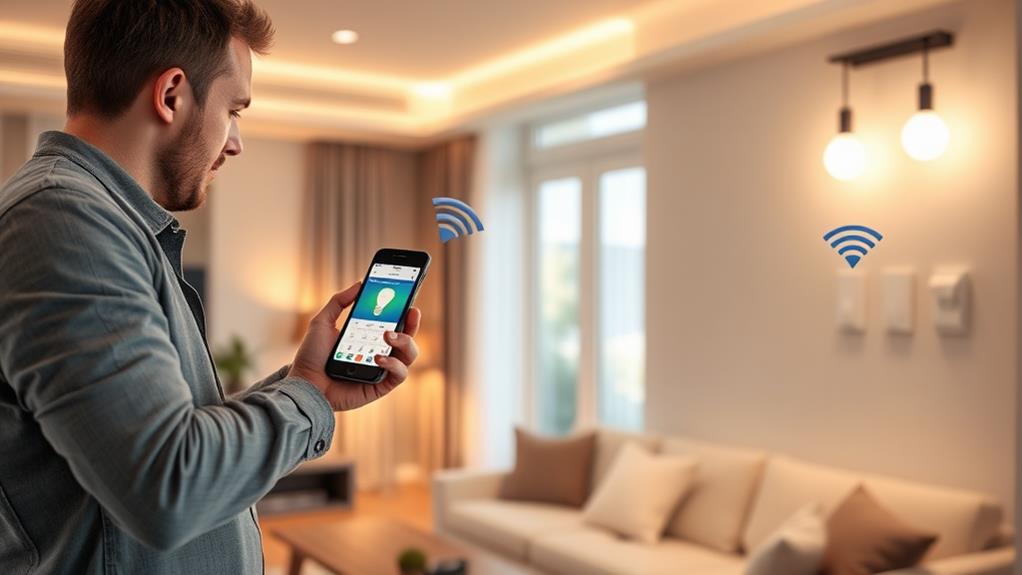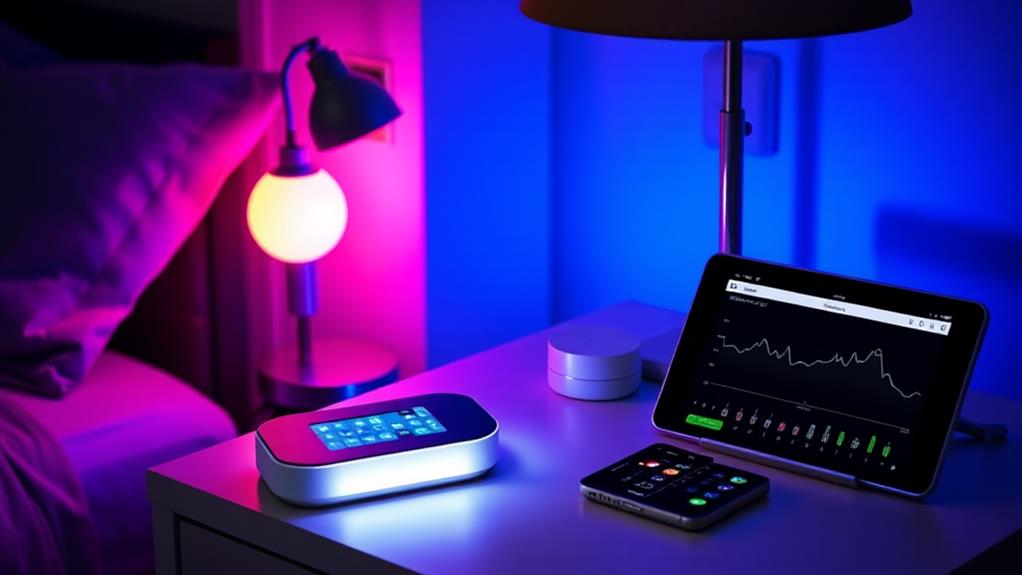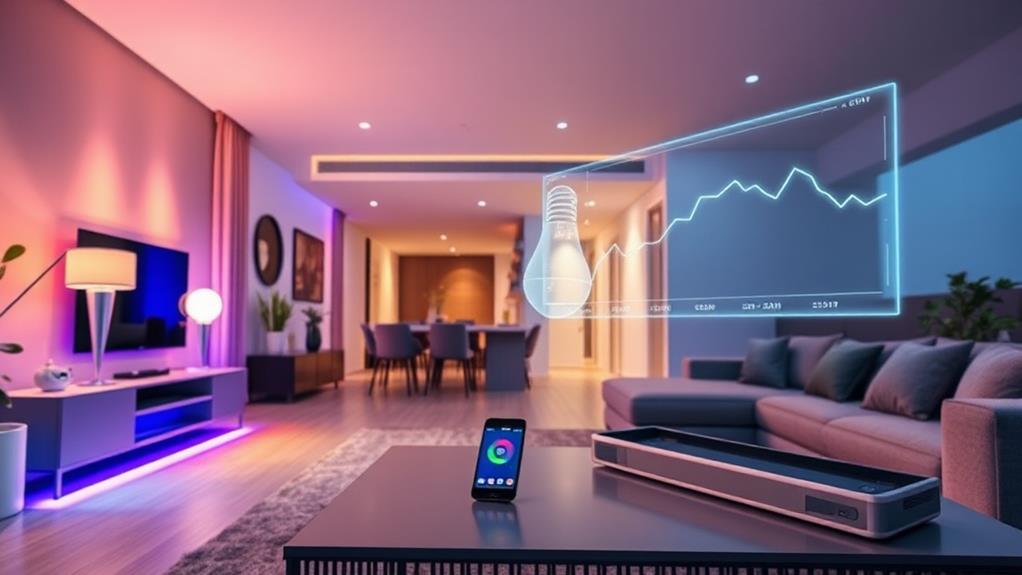Smart lighting systems offer you unparalleled control over your home's illumination. These Wi-Fi-connected LED bulbs can be managed through smartphone apps or voice assistants, allowing remote control, scheduling, and dimming. You'll enjoy color-changing capabilities, occupancy sensors, and precise brightness adjustments. The energy-efficient LEDs consume up to 75% less power than traditional bulbs, leading to significant cost savings. Installation is straightforward, involving connecting a hub to your Wi-Fi and adding compatible bulbs. Integration with other smart home devices enhances automation and efficiency. By exploring smart lighting technology, you'll unlock a world of convenience, customization, and energy optimization for your living spaces.
Understanding Smart Lighting Technology

Imagine a world where your lights anticipate your needs before you even flip a switch. That's the reality of smart lighting technology. These systems use a combination of sensors, wireless connectivity, and advanced software to create an intelligent lighting environment in your home or office.
At the core of smart lighting are LED bulbs equipped with microprocessors and wireless radios. These bulbs can connect to your home's Wi-Fi network or communicate via protocols like Zigbee or Bluetooth. You'll control them through smartphone apps, voice assistants, or dedicated hubs.
Smart lighting systems offer features like remote control, scheduling, and dimming. They can adjust color temperature to mimic natural daylight patterns, potentially improving your sleep and productivity. Some advanced systems use motion sensors to automatically turn lights on or off as you enter or leave a room.
Energy efficiency is a major benefit. Smart bulbs consume less power than traditional ones, and their ability to automatically turn off when not needed further reduces energy waste. Many systems also provide detailed energy usage reports, helping you optimize your lighting habits for maximum savings.
Key Features and Benefits
Smart lighting systems come packed with a range of features that set them apart from traditional lighting. You'll find that most smart bulbs offer color-changing capabilities, allowing you to adjust the ambiance of your room with a tap on your smartphone. Dimming functionality is another standard feature, giving you precise control over brightness levels without the need for separate dimmer switches.
One of the most significant benefits of smart lighting is energy savings. These systems often include occupancy sensors and scheduling options, ensuring lights are only on when needed. You can set routines to automatically turn lights off when you leave for work or dim them in the evening. Many smart bulbs are also highly energy-efficient LED models, further reducing your electricity consumption.
Remote control capabilities let you manage your lighting from anywhere, providing both convenience and security. You can turn lights on while away to deter potential intruders or ensure a well-lit welcome when you return home. Integration with voice assistants like Alexa or Google Home adds hands-free control, making it easy to adjust your lighting without interrupting your activities.
Installation and Setup Process

Getting started with a smart lighting system is often simpler than you might expect. Begin by choosing compatible smart bulbs or fixtures for your existing sockets. Most systems don't require additional wiring, making them ideal for renters or those hesitant about electrical work.
Next, download the manufacturer's app on your smartphone or tablet. This app will guide you through the setup process. You'll need to connect the smart hub (if required) to your home's Wi-Fi network. Then, install the bulbs and use the app to detect and add them to your system.
Once connected, you can name each bulb or group them by room for easier control. Many systems allow you to create schedules, scenes, and automations. You might set your lights to gradually brighten in the morning or dim in the evening.
For voice control, link your smart lighting system to a compatible virtual assistant like Amazon Alexa or Google Home. This integration usually involves a few simple steps in the assistant's app.
Remember to keep your system's firmware updated for optimal performance and security. With everything set up, you're ready to enjoy the convenience and energy savings of your new smart lighting system.
Energy Efficiency and Cost Savings
In terms of energy efficiency and cost savings, smart lighting systems offer significant advantages over traditional setups. You'll notice an immediate reduction in your energy consumption as these systems automatically adjust brightness levels and turn off lights in unoccupied rooms. Many smart bulbs use LED technology, which consumes up to 75% less energy than incandescent bulbs while lasting much longer.
You can easily program your lights to follow your daily routines, ensuring they're only on when needed. Motion sensors and geofencing features further optimize energy use by detecting your presence and adjusting accordingly. With smartphone apps, you'll have real-time control over your home's lighting, even when you're away, preventing unnecessary energy waste.
The initial investment in smart lighting may be higher, but you'll recoup costs through lower electricity bills. Some utility companies offer rebates for energy-efficient upgrades, further offsetting your expenses. Additionally, the extended lifespan of smart bulbs means you'll spend less on replacements over time. By monitoring your energy usage through the system's analytics, you can identify areas for improvement and make informed decisions to maximize your savings.
Integration With Smart Home Systems

One of the key advantages of smart lighting systems is their seamless integration with other smart home devices. You can easily connect your smart lights to voice assistants like Amazon Alexa, Google Assistant, or Apple HomeKit, allowing you to control your lighting with simple voice commands. This integration extends to other smart home devices, such as motion sensors, door locks, and thermostats.
By linking your smart lighting to these devices, you can create automated routines that enhance your home's efficiency and security. For instance, you can set your lights to turn on automatically when your smart door lock is unlocked or when motion is detected in a specific area. You can also synchronize your lights with your smart thermostat to create the perfect ambiance based on the room's temperature.
Many smart lighting systems offer compatibility with IFTTT (If This Then That) services, enabling you to create custom automation recipes. This allows you to integrate your lights with a wide range of apps and services, from weather forecasts to social media notifications, further expanding the possibilities of your smart home ecosystem.
Conclusion
You've seen how smart lighting can revolutionize your home. It's not just about convenience; it's about saving energy and money too. As they say, "A penny saved is a penny earned." By embracing this technology, you're not only stepping into the future but also making a smart investment. Whether you're tech-savvy or just starting out, smart lighting is an accessible way to enhance your living space and reduce your carbon footprint.

